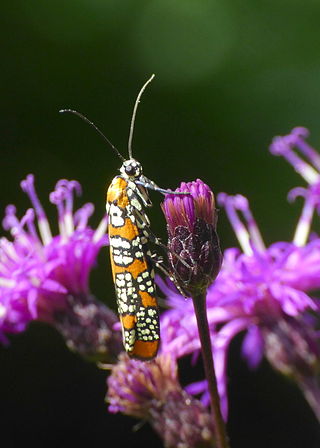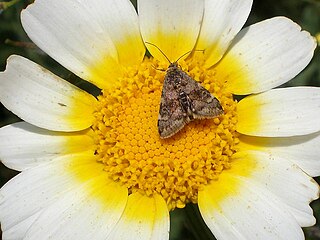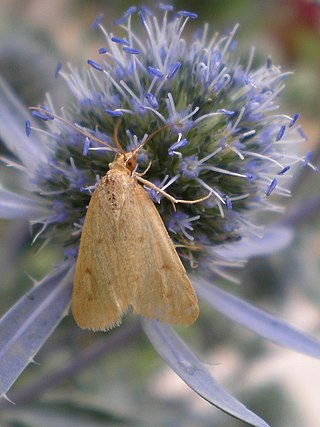
The ailanthus webworm is an ermine moth now found commonly in the United States. It was formerly known under the scientific name Atteva punctella. This small, very colorful moth resembles a true bug or beetle when not in flight, but in flight it resembles a wasp.

The Pyralidae, commonly called pyralid moths, snout moths or grass moths, are a family of Lepidoptera in the ditrysian superfamily Pyraloidea. In many classifications, the grass moths (Crambidae) are included in the Pyralidae as a subfamily, making the combined group one of the largest families in the Lepidoptera. The latest review by Eugene G. Munroe and Maria Alma Solis retain the Crambidae as a full family of Pyraloidea.

The Pyraloidea are a moth superfamily containing about 16,000 described species worldwide, and probably at least as many more remain to be described. They are generally fairly small moths, and as such, they have been traditionally associated with the paraphyletic Microlepidoptera.

Spilomelinae is a very species-rich subfamily of the lepidopteran family Crambidae, the crambid snout moths. With 4,135 described species in 344 genera worldwide, it is the most speciose group among pyraloids.

Spoladea recurvalis, the beet webworm moth or Hawaiian beet webworm moth, is a species of moth of the family Crambidae. It is found worldwide, but mainly in the tropics.

Epipagis is a genus of moths of the family Crambidae described by Jacob Hübner in 1825.
Hymenia is a genus of moths of the family Crambidae.

Eois is a genus of tropical moths in the family Geometridae. It was first described by Jacob Hübner in 1818. Caterpillars of Eois species are most commonly green with darker markings, but species with fully dark caterpillars also exist. They are specialized feeders associated with Piperaceae species, with sparse additional records on Chloranthaceae species. Adults are typically small, with diverse wing shape, color and patterning across the genus.

Palthis angulalis, the dark-spotted palthis, is a moth of the family Erebidae. The species was first described by Jacob Hübner in 1796. It is found from Newfoundland west to coastal British Columbia, south to Florida and Texas.

Hellula rogatalis, the cabbage webworm, is a moth of the family Crambidae described by George Duryea Hulst in 1886. It is found from the southern United States north in the east to Maryland, New York and Ontario. It is also found in Mexico, where it has been recorded from Distrito Federal.

Chrysoteuchia topiarius, the topiary grass-veneer moth, subterranean sod webworm or cranberry girdler, is a moth of the family Crambidae. The species was first described by Philipp Christoph Zeller in 1866. It is found in most of North America.

Aporodes floralis is a species of moth in the family Crambidae first described by Jacob Hübner in 1809. It is found in most of continental Europe, Algeria, Syria, Afghanistan, central Asia, north-western India and Yemen

Achyra nudalis is a moth of the family Crambidae. It was described by Jacob Hübner in 1796. It is found from southern Europe east to India and Mongolia. It has also been recorded from Yemen, Niger, Saudi Arabia and South Africa.

Tegostoma comparalis is a species of moth in the family Crambidae. It was described by Jacob Hübner in 1796. It is found in Spain, France, Italy, Croatia, North Macedonia, Greece, Bulgaria, Romania, Ukraine, Kyrgyzstan, North Africa, India, Pakistan, the Near East, Turkmenistan, the United Arab Emirates, Yemen, South Africa and Niger.

Herpetogramma bipunctalis, commonly known as the southern beet webworm moth or two-spotted herpetogramma, is a species of moth in the family Crambidae. It is found from New England to Florida, west to Texas and north to Illinois. In the south, the range extends through Central America and the Caribbean to South America.

Loxostege commixtalis, the alfalfa webworm, is a species of moth in the family Crambidae. It was described by Francis Walker in 1866. It is found in Fennoscandia, Estonia and northern Russia. It is also found in North America, where it ranges from Nova Scotia and Newfoundland and Labrador west to the Yukon.

Herpetogramma phaeopteralis, commonly known as the dark sod webworm, is a species of moth in the family Crambidae. It was described by Achille Guenée in 1854.
Hymeniini is a tribe of the species-rich subfamily Spilomelinae in the pyraloid moth family Crambidae. The tribe was erected by Charles Swinhoe in 1900.


















